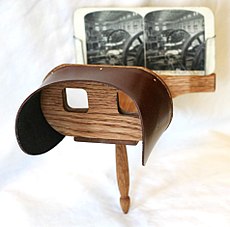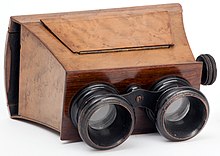
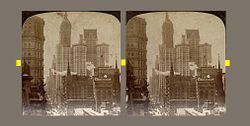
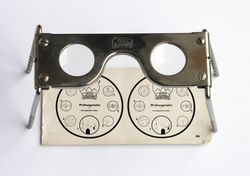
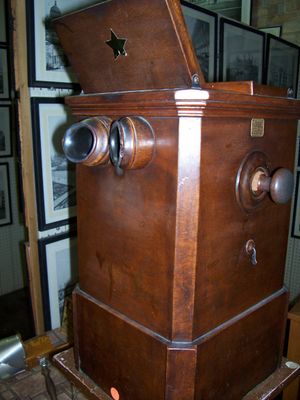
المجسام Stereoscope ..الاستريوسكوب.. المجسام ..
الرؤية المجسمة:
التصوير ثلاثي الأبعاد (Stereoscopy، stereoscopic أو3-D imaging)، هي تقنية تتيح تسجيل معلومات مرئية ثلاثية الأبعاد أو انشاء عمق وهمي في الصورة. وهذه الطريقة تقلد عمل العينين. فالعينان تكونان صورتين مختلفتين قليلا للجسم المرئي بسبب فرق المسافة بين العينين، وترسل العينان الصورتين إلى المخ حيث يتم دمج الصورتين فيظهر الشيئ أمامنا مجسما، أي أننا نستطيع تقدير البعد على الصورة. أما باستخدام عين واحدة فلا يمكننا تحديد العمق أو بعد الأشياء المرئية.
التقاط الصور:
تستخدم كاميرا ذات عدستين للتصوير الثلاثي الأبعاد ، وتتم عملية التصوير كالمعتاد ولكن في كل لقطة تصور صورتين . ولمشاهدة الصورة المجسمة ، ينظر بالعين اليمنى غلى الصورة اليمنى ويُنظر بالعين اليسرى إلى الصورة اليسرى (قد يسهلن وضع حائل بين الصورتين عملية الرؤية) . تقوم العينان والمخ بتركيب الصورة المجسمة تلقائيا.
وخلال الحرب العالمية الثانية كانت طائرات التصوير تطير فوق مواقع العدو وتلتقت الصور المجسمة ، وعند العودة إلى قواعدهم يقوم المختصون بتحليل الصور و تعيين مواقع العدو بغية قذفها بالقنابل فيما بعد.
ــــــــــــــــــــــ
A stereoscope is a device for viewing a stereoscopic pair of separate images, depicting left-eye and right-eye views of the same scene, as a single three-dimensional image.
A typical stereoscope provides each eye with a lens that makes the image seen through it appear larger and more distant and usually also shifts its apparent horizontal position, so that for a person with normal binocular depth perception the edges of the two images seemingly fuse into one “stereo window”. In current practice, the images are prepared so that the scene appears to be beyond this virtual window, through which objects are sometimes allowed to protrude, but this was not always the custom. A divider or other view-limiting feature is usually provided to prevent each eye from being distracted by also seeing the image intended for the other eye.
Most people can, with practice and some effort, view stereoscopic image pairs in 3D without the aid of a stereoscope, but the physiological depth cues resulting from the unnatural combination of eye convergence and focus required will be unlike those experienced when actually viewing the scene in reality, making an accurate simulation of the natural viewing experience impossible and tending to cause eye strain and fatigue.
Although more recent devices such as Realist-format 3D slide viewers and the View-Master are also stereoscopes, the word is now most commonly associated with viewers designed for the standard-format stereo cards that enjoyed several waves of popularity from the 1850s to the 1930s as a home entertainment medium.
Devices such as polarized, anaglyph and shutter glasses which are used to view two actually superimposed or intermingled images, rather than two physically separate images, are not categorized as stereoscopes.
Holmes stereoscope
In 1861 Oliver Wendell Holmes created and deliberately did not patent a handheld, streamlined, much more economical viewer than had been available before. The stereoscope, which dates from the 1850s, consisted of two prismatic lenses and a wooden stand to hold the stereo card. This type of stereoscope remained in production for a century and there are still companies making them in limited production currently.
Modern use
In the mid-20th century the View-Master stereoscope (patented 1939), with its rotating cardboard disks containing image pairs, was popular first for ‘virtual tourism’ and then as a toy. In 2010, Hasbro started producing a stereoscope designed to hold an iPhone or iPod Touch, called the My3D. In 2014, Google released the template for a papercraft stereoscope called Google Cardboard. Apps on the mobile phone substitute for stereo cards; these apps can also sense rotation and expand the stereoscope’s capacity into that of a full-fledged virtual reality device. The underlying technology is otherwise unchanged from earlier stereoscopes.
Several fine arts photographers and graphic artists have and continue to produce original artwork to be viewed using stereoscopes.
Principles
A simple stereoscope is limited in the size of the image that may be used. A more complex stereoscope uses a pair of horizontal periscope-like devices, allowing the use of larger images that can present more detailed information in a wider field of view. The stereoscope is essentially an instrument in which two photographs of the same object, taken from slightly different angles, are simultaneously presented, one to each eye. This recreates the way which in natural vision, each eye is seeing the object from a slightly different angle, since they are separated by several inches, which is what gives humans natural depth perception. Each picture is focused by a separate lens, and by showing each eye a photograph taken several inches apart from each other and focused on the same point, it recreates the natural effect of seeing things in three dimensions.
A moving image extension of the stereoscope has a large vertically mounted drum containing a wheel upon which are mounted a series of stereographic cards which form a moving picture. The cards are restrained by a gate and when sufficient force is available to bend the card it slips past the gate and into view, obscuring the preceding picture. These coin-enabled devices were found in arcades in the late 19th and early 20th century and were operated by the viewer using a hand crank. These devices can still be seen and operated in some museums specializing in arcade equipment.
The stereoscope offers several advantages:
Using positive curvature (magnifying) lenses, the focus point of the image is changed from its short distance (about 30 to 40 cm) to a virtual distance at infinity. This allows the focus of the eyes to be consistent with the parallel lines of sight, greatly reducing eye strain.
The card image is magnified, offering a wider field of view and the ability to examine the detail of the photograph.
The viewer provides a partition between the images, avoiding a potential distraction to the user.
A stereo transparency viewer is a type of stereoscope that offers similar advantages, e.g. the View-Master.
Disadvantages of stereo cards, slides or any other hard copy or print are that the two images are likely to receive differing wear, scratches and other decay. This results in stereo artifacts when the images are viewed. These artifacts compete in the mind resulting in a distraction from the 3D effect, eye strain and headaches.

المجسام ( Stereoscope )
المِجْسَام أداة بصرية تُظهر الصور للعين مجسمة ذات أبعاد ثلاثة. تري آلة التصوير العادية الأشياء في سطح مستو وليس بالطريقة المجسمة التي ترى بها أعيننا الأشياء عادة، إلا أن آلتين من آلات التصوير بينهما مسافة قصيرة يمكنهما رؤية الأشياء كما تراها أعيننا فهما يستطيعان تصوير الجسم نفسه في الوقت نفسه. وإذا تمَّ وضع الصورتين جنبًا إلى جنب ونُظر إليهما بأداة المجسام يبدو الشكل الناتج ذا ثلاثة أبعاد لذلك يرى الإنسان الذي يستعمل المجسام جميع الأشياء مجسمة.
كان المجسام ـ الذي يحتوي على خزانة للصور ـ منتشرًا في وقت من الأوقات. ويتكون النوع القديم من المجسام من حامل ومقبض وشريحة منزلقة وعدستي منشور. أما مجسام اليوم فهو صندوق من البلاستيك له عدستان. وهناك نوع مشهور له شرائح للتصوير مركبة على لوح من الورق المقوّى، أو على قرص من البلاستيك.
وفي الوقت الحاضر يستعمل المجسام على نطاق واسع في المسح الجوي لرسم تضاريس الأرض. ويستعمل علماء الفلك نوعًا خاصًا من المِجْسَام لرؤية الكواكب الصغيرة.
وفي عام 1952م أدخل المنتجون آلة تصوير سينمائي ثلاثية الأبعاد. واستعملت في بعض أنواعها شاشة كبيرة مقوسة وطريقة جديدة من نظام الإسقاط لإنتاج صور ثلاثية الأبعاد .وفي بعضها الآخر استخدمت نظرية المجْسام حيث كان مشاهدو الفيلم يستخدمون نظارات خاصة، حتى ترى كل عين المنظر المخصص لها، لكي يبدو الشكل المتخيل ذا أبعاد ثلاثة.
★ تَصَفح أيضًا: الضوء المستقطب ؛ آلة التصوير ؛ العين.
المصدر: الموسوعة العربية العالمية
استغلال الألوان المتكاملة
لجأت السينما وبعض الصور الفوتوغرافية إلى الاستعاضة عن تصوير صورتين توضع بجانب بعضها للتصوير المجسم وذلك بتسجيل الصورتين بلونين متكاملين على نفس الصورة (أنظر الصورة). ومن أجل رؤية الصور المجسمة في السينما مثلا يلبس المشاهد نظارة ذات لونين (الأحمر والقرمزي) . بذلك تري العين اليمني الصورة اليمنى والعين اليسرى الصورة اليسرى ويتحقق خيال التجسيم .


